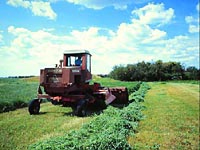|

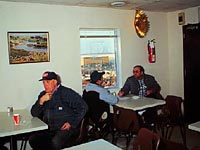 |
Particularly during the winter months, many of the business and social exchanges of farming and ranching happen over coffee in the friendly atmosphere of the cafes of rural Saskatchewan. |
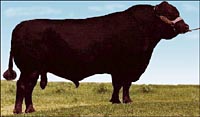 |
High quality bulls, like this Aberdeen Angus, father hundreds of calves per year through artificial insemination (Al). Al for range cattle was pioneered in Saskatchewan.
|
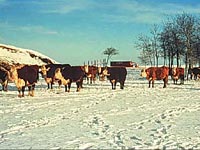
|
Cattle graze on pasture in summer, but in the winter months must be fed hay or silage. Saskatchewan winters can be severe. Cattle must be well-fed and have access to water and shelter to thrive in winter. Saskatchewan ranchers have longer feeding periods than most other areas, sometimes hauling feed to cattle nine months of the year. |
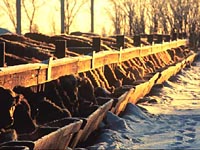 |
Feedlot operations fatten cattle for the meat market. They are fed grain-based rations that are high in protein and carbohydrates. Most cattle in feedlots are steers. They are fed until they are well fleshed, and weighing 450 to 570 kilograms, and then sold to be slaughtered for meat.
|
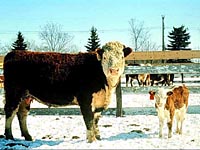 |
Most calves are born in late winter or early spring, while the cows are close at hand near the farmstead or ranch. This cow and its calf are Herefords, a hardy breed of cattle especially well-suited to the open range, and able to prosper during the harsh winters with only protection from the wind.
|
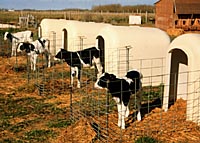
|
Some young dairy calves must be protected if they are to stay outside by themselves in the winter. |

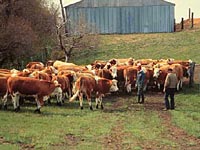
|
Cows being moved from winter-time shelter and feeding to spring pasture. Cattle, just like people, enjoy those first warm days of spring and the chance to ramble over the pastures in search of new grass, or to just ramble. During this time, cows shed the long hair grown to keep them warm in winter.
|
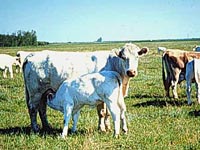
|
Suckled by its mother, a partly grown calf obtains the nutritious milk that allows it to grow. Beef cows do not produce nearly as much milk as dairy cows, but they need to be good milk producers to raise healthy, fast-growing calves. Calves remain with their mothers from birth until about seven
to eight months of age, and gradually progress from a diet of milk to one that is mainly grass or hay.
|
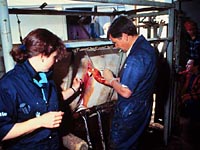
|
Veterinarians attending to a cow held firmly in a squeeze that protects both the animal, and the people who must work with it at close quarters. Routine procedures such as vaccination, generally are handled by the farmer or rancher, with veterinarians required to treat sickness and, occasionally, assist with the birth of calves.
|
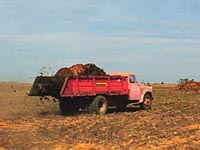
|
Manure accumulates in the winter-time shelters with the straw that is added for bedding. In spring,the manure is loaded, transported to the fields and spread on the land. Manure provides nutrients, such as nitrogen and phosphorus, and fibre to increase the organic matter content of the soil.
|


|
Round or cylindrical bales, compressed by a baler, contain about 550 kilograms of hay. Round bales are preferred by many farmers because they are well-suited to mechanical handling. Cows require about 2000 kilograms of hay each winter.
|
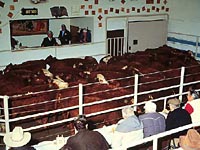
|
Cattle may be sold by auction. Single animals or groups of similar animals are herded into the auction ring, their total weight displayed, and bid on by potential buyers. Auctioneers use a lively and colourful patter to encourage bids, until the highest bid takes the lot.
|

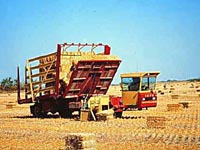
|
A bale-wagon loads rectangular bales of hay, transports them to a storage lot near the cattle feeding area, and unloads them mechanically. Balers and bale-wagons lessen considerably the heavy work of haying.
|
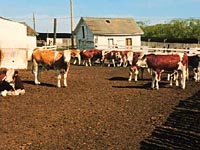
|
A group of steers being fed grain and hay rather than grazing pastures. The markings on these steers indicate that they are crosses of different breeds, resulting in animals that grow faster and efficiently convert feed into meat protein.
|
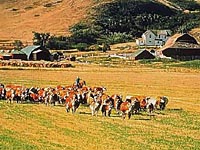
|
Cowboys mounted on horses moving a herd of cattle near a ranch in southwest Saskatchewan. The semi-arid grasslands of this region are suited to grazing, and are used by ranchers who combine traditional methods with new technologies to produce cattle efficiently.
|
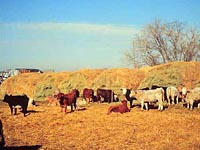
|
Cattle seen in late autumn, in a sheltered area where they may remain throughout the winter. Cattle require shelter from wind and heavy snow but are able to withstand cold temperatures as long as they are well fed. Calves, on the other hand, generally need special housing.
|
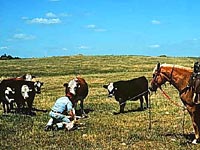
|
Out on the open range, calves needing attention can be caught by a skillfully thrown rope or lasso. The well-trained quarter horse holds the rope taut, allowing the stockman to attend to tasks such as branding or vaccinating.
|
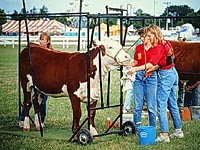
|
Farm children often participate in 4-H clubs to have fun, and to acquire the knowledge and skills that are important to rural living. These youngsters are grooming a heifer that they have raised, in preparation for a livestock show. Showing cattle at fairs is an effective way of letting others know the quality of your herd.
|
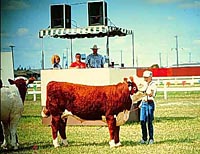
|
A young livestock showman presenting his steer. In this competition both the quality of the animal and the manner in which it is shown are judged. The steer was selected as a superior calf, and has been fed the best of feed in order to have a large, well-fleshed and healthy looking animal for the show.
|
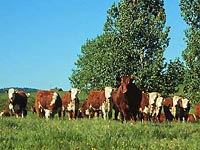
|
Cattle are ruminants, able to make use of cellulose-rich feed like grass. The feed is broken down by bacteria and protozoa present in the rumen, or first part of the digestive tract. Cattle graze for a few hours, and then rest while chewing their cud. The cud is a bolous or mass of food regurgitated from the rumen.
|
| 










